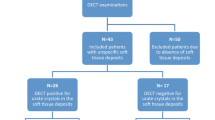Abstract
Objectives
Dual-energy computed tomography (DECT) is an emerging imaging technique for examining patients with suspected gout. Single-source dual-energy CT (S-DECT) is a new way of obtaining DECT information on conventional CT scanners rather than using special dual-source CT systems.
Methods
We tested the feasibility of S-DECT (320-row CT; Aquilion ONE, Toshiba Medical Systems, Otawara, Japan) in 6 patients (5 men, 1 woman; mean age 61.3, range 48 to 69 years) with acute arthralgia and suspected gout, and compared the S-DECT findings with the results of joint aspiration.
Results
Three patients had a diagnosis of gouty arthritis with negatively birefringent crystals in synovial fluid, in addition to gouty tophi in S-DECT. Three patients had no detectable crystals by polarization microscopy and no tophi on DECT. Their final diagnoses were rheumatoid arthritis, activated osteoarthritis, and septic arthritis in one case each.
Conclusion
This initial experience suggests that S-DECT might be a valuable alternative to dual-source CT. Hence, more patients may benefit from its additional diagnostic abilities in the future.

Similar content being viewed by others
Explore related subjects
Discover the latest articles and news from researchers in related subjects, suggested using machine learning.References
Bongartz T, Glazebrook KN, Kavros SJ, Murthy NS, Merry SP, Franz WB, et al. Dual-energy CT for the diagnosis of gout: an accuracy and diagnostic yield study. Ann Rheum Dis. 2015;74(6):1072–7.
Dalbeth N, Aati O, Kalluru R, Gamble GD, Horne A, Doyle AJ, et al. Relationship between structural joint damage and urate deposition in gout: a plain radiography and dual-energy CT study. Ann Rheum Dis. 2015;74(6):1030–6.
Choi HK, Burns LC, Shojania K, Koenig N, Reid G, Abufayyah M, et al. Dual energy CT in gout: a prospective validation study. Ann Rheum Dis. 2012;71:1466–71.
Kim S-K, Lee H, Kim JH, Park S-H, Lee SK, Choe J-Y. Potential interest of dual-energy computed tomography in gout: focus on anatomical distribution and clinical association. Rheumatology. 2013;52:402–3.
Morsbach F, Wurnig MC, Müller D, Krauss B, Korporaal JG, Alkadhi H. Feasibility of single-source dual-energy computed tomography for urinary stone characterization and value of iterative reconstructions. Investig Radiol. 2013;49:125–30.
Wright JD, Pinto AB. Clinical manifestations and treatment of gout. Prim Care Update Ob Gyns. 2003;10:19–23.
Zhang W, Doherty M, Bardin T, Pascual E, Barskova V, Conaghan P, et al. EULAR evidence based recommendations for gout. II. Management. Report of a task force of the EULAR standing committee for international clinical studies including therapeutics (ESCISIT). Ann Rheum Dis. 2006;65:1312–24.
Mathieu S, Pereira B, Couderc M, Soubrier M. Usefulness of ultrasonography in the diagnosis of gout: a meta-analysis. Ann Rheum Dis. 2013;72:e23.
Pascual E, Doherty M. Aspiration of normal or asymptomatic pathological joints for diagnosis and research: indications, technique and success rate. Ann Rheum Dis. 2009;68:3–7.
Huppertz A, Hermann K-GA, Diekhoff T, Wagner M, Hamm B, Schmidt WA. Systemic staging for urate crystal deposits with dual-energy CT and ultrasound in patients with suspected gout. Rheumatol Int. 2014;34(6):763–71.
Dalbeth N, Schauer C, MacDonald P, Perez-Ruiz F, Schumacher HR, Hamburger S, et al. Methods of tophus assessment in clinical trials of chronic gout: a systematic literature review and pictorial reference guide. Ann Rheum Dis. 2011;70:597–604.
Melzer R, Pauli C, Treumann T, Krauss B, editors. Gout tophus detection—a comparison of dual-energy CT (DECT) and histology. Semin Arthritis Rheum. 2014;43(5):662–5.
Gruber M, Bodner G, Rath E, Supp G, Weber M, Schueller-Weidekamm C. Dual-energy computed tomography compared with ultrasound in the diagnosis of gout. Rheumatology. 2014;53(1):173–9.
Saltybaeva N, Jafari ME, Hupfer M, Kalender WA. Estimates of effective dose for CT scans of the lower extremities. Radiology. 2014;273(1):153–9.
Hu HJ, Liao MY, Xu LY. Clinical utility of dual-energy CT for gout diagnosis. Clin Imaging. 2015. doi:10.1016/j.clinimag.2014.12.015.
Dalbeth N, Stamp L. Hyperuricaemia and gout: time for a new staging system? Ann Rheum Dis. 2014;73(9):1598–600.
Sivera F, Andres M, Falzon L, van der Heijde DM, Carmona L. Diagnostic value of clinical, laboratory, and imaging findings in patients with a clinical suspicion of gout: a systematic literature review. J Rheumatol Suppl. 2014;92:3–8.
Grainger R, Dalbeth N, Keen H, Durcan L, Edwards NL, Perez-Ruiz F, et al. Imaging as an outcome measure in gout studies: report from the OMERACT gout working group. J Rheumatol. 2015. doi:10.3899/jrheum.141164.
Dalbeth N, House ME, Aati O, Tan P, Franklin C, Horne A, et al. Urate crystal deposition in asymptomatic hyperuricaemia and symptomatic gout: a dual energy CT study. Ann Rheum Dis. 2015;74(5):908–11.
Bongartz T, Glazebrook KN, Kavros SJ, Murthy NS, Merry SP, Franz WB, et al. Dual-energy CT for the diagnosis of gout: an accuracy and diagnostic yield study. Ann Rheum Dis. 2015;74(6):1072–7.
Schellingerhout D, Lev MH, Bagga RJ, Rincon S, Berdichevsky D, Thangaraj V, et al. Coregistration of head CT comparison studies: assessment of clinical utility. Acad Radiol. 2003;10(3):242–8.
Jepperson MA, Cernigliaro JG, el Ibrahim SH, Morin RL, Haley WE, Thiel DD. In vivo comparison of radiation exposure of dual-energy CT versus low-dose CT versus standard CT for imaging urinary calculi. J Endourol. 2015;29(2):141–6.
McQueen FMF, Doyle AJ, Reeves Q, Gamble GD, Dalbeth N. DECT urate deposits: now you see them, now you don’t. Ann Rheum Dis. 2013;72(3):458–9.
Conflict of interest
This work was supported by Toshiba Medical Systems. JM is an employee of Toshiba Medical Systems Europe and took part in the study design and the writing of the manuscript.
Author information
Authors and Affiliations
Corresponding author
Rights and permissions
About this article
Cite this article
Diekhoff, T., Ziegeler, K., Feist, E. et al. First experience with single-source dual-energy computed tomography in six patients with acute arthralgia: a feasibility experiment using joint aspiration as a reference. Skeletal Radiol 44, 1573–1577 (2015). https://doi.org/10.1007/s00256-015-2204-7
Received:
Revised:
Accepted:
Published:
Issue Date:
DOI: https://doi.org/10.1007/s00256-015-2204-7




